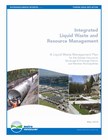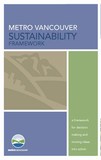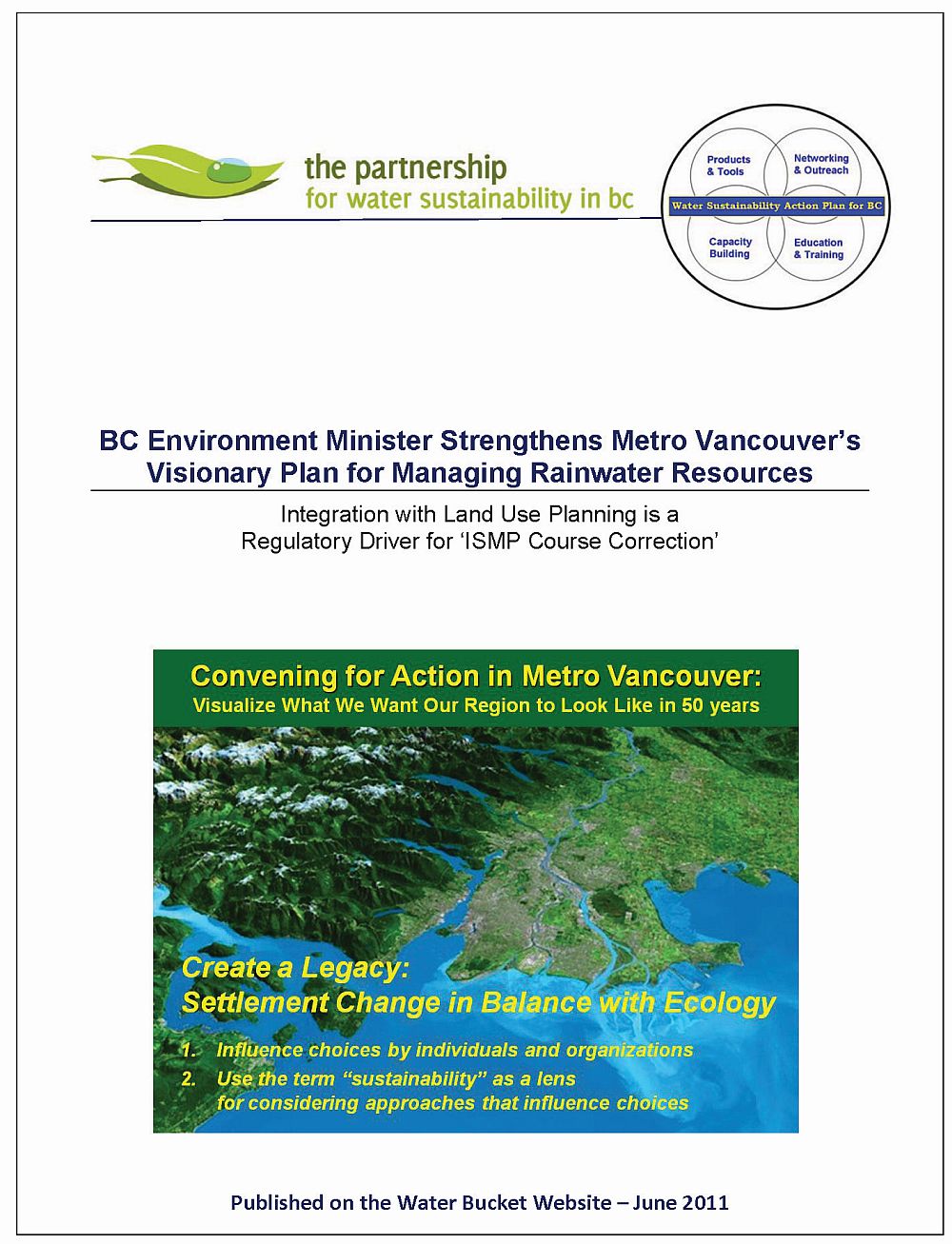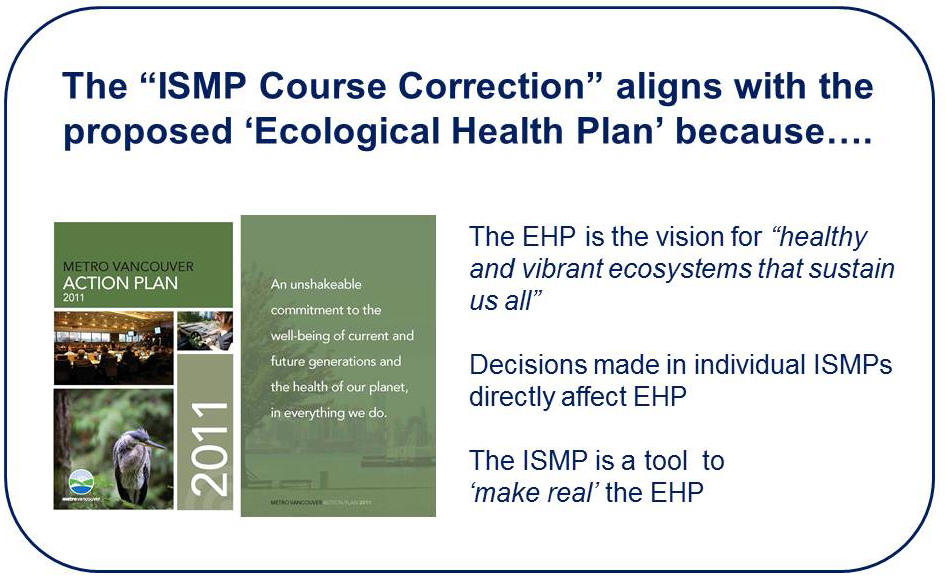Sustainable Service Delivery: Province Strengthens Metro Vancouver’s Plan for Managing Rainwater Resources
Note to Reader:
In May 2010, the Metro Vancouver region adopted a holistic strategy for managing liquid discharges and rainwater resources. Two years in the making, the Integrated Liquid Waste & Resource Management Plan established the framework for moving beyond regulatory compliance to transitioning Metro Vancouver to an approach where watershed-based planning is integrated within a broader, sustainability framework.
In February 2011, the Partnership for Water Sustainability in British Columbia released a guidance document to help municipalities implement a course correction in the way Integrated Stormwater Management Plans (ISMPs) are undertaken. The image below illustrates the essence of the paradigm-shift.
In June 2011, the Minister of Environment announced that the Province has approved Metro Vancouver’s visionary plan. He also strengthened the plan by imposing conditions that expand what is expected of Metro Vancouver’s member municipalities vis-à-vis rainwater management.
The Minister’s conditions are aligned with both the ISMP Course Correction and the region’s proposed Ecological Health Plan. This article connects the dots between the three. It also introduces the concept of Sustainable Service Delivery as the way to (re)focus ISMPs on a life-cycle way of thinking about infrastructure needs and how to pay for them over time
To download a report-style PDF document version of the article below, click on BC Environment Minister Strengthens Metro Vancouver’s Visionary Plan for Managing Rainwater Resources.
Integration with Land Use Planning is a Regulatory Driver for ‘ISMP Course Correction’
Completed in 2010, the Metro Vancouver region’s Integrated Liquid Waste & Resource Management Plan (i.e. ‘the Integrated Plan’) has established the framework for moving beyond regulatory compliance and implementing a ‘design with nature’ philosophy that is outcome-oriented and achieves the Sustainable  Region Vision.
Region Vision.
The Integrated Plan is aligned with, and supports, the provincial policy framework established by the Living Water Smart and Green Communities initiatives. Furthermore, the strategy for managing liquid discharges and rainwater as resources has two tracks: End-of-Pipe and At-the-Source.
“The plan deals with the pressures of an increasing population while planning to bring an aging infrastructure up to modern standards,” stated Environment Minister Terry Lakes in June 2011 when he announced that the Province has approved the plan.
Sustainable Region Vision
Since 2002, Metro Vancouver has formally put the concept of sustainability at the centre of its operating and planning philosophy, and has committed itself to be a leader.
 In 2008, the Metro Vancouver Sustainability Framework brought together all the strands of the Sustainable Region Initiative (SRI) as a means of communicating where Metro Vancouver intends to go. The Integrated Plan for managing rainwater as a resource now provides the means to translate the Sustainability Framework into tangible actions on the ground.
In 2008, the Metro Vancouver Sustainability Framework brought together all the strands of the Sustainable Region Initiative (SRI) as a means of communicating where Metro Vancouver intends to go. The Integrated Plan for managing rainwater as a resource now provides the means to translate the Sustainability Framework into tangible actions on the ground.
The strategies and actions in the Integrated Plan will have an impact on Metro Vancouver’s sustainability for generations to come.
Ministerial Conditions for Approval of Integrated Plan
In a letter to the Metro Vancouver Board, BC Environment Minister Terry Lake commended the region’s plan while at the same time advising that it does not fully meet his requirements. So he has strengthened the plan by imposing conditions that expand municipal actions vis-à-vis rainwater management.
ISMP Effectiveness
“Member municipalities will, with Metro Vancouver planning and coordination, and to the satisfaction of the Regional Manager, develop a coordinated program to monitor stormwater and assess and report the implementation and effectiveness of  Integrated Storm Water Management Plans (ISMP),” stated the Minister under Condition #7.
Integrated Storm Water Management Plans (ISMP),” stated the Minister under Condition #7.
“The program will use a weight-of-evidence performance measurement approach and will report out in the Biennial Report. The Regional Manager may extend the deadline for completion of ISMP by municipalities from 2014 to 2016 if satisfied that the assessment program could result in improvement of ISMP and protect stream health.”
Integration with Land Use Planning
Under Condition #9, the Minister stated that: “The ILWRMP has a goal of protecting public health and the environment. In keeping with this goal and to ensure alignment with other national, provincial and regional initiatives, Metro Vancouver and member municipalities are encouraged to:
- have land use planning consider the direction provided by the ISMPs;
- consider how the degree, type and location of land development within a drainage can affect the long-term health of the watershed;
- consider how to protect the stream, including the riparian areas that exert an influence on the streams, from long-term cumulative impacts; and
- use scenarios and forecasting to systematically consider environmental consequences/benefits of different land use approaches prior to build-out (for example. Alternative Future type approaches).”
The Minister’s letter also pointed out that “coordination with municipal planners through forums such as Metro Vancouver’s Technical Advisory Committee will be important to successful integration.”
Reference Panel Perspective
Appointed by the Metro Vancouver Board in April 2008, the advisory Liquid Waste Management Plan Reference Panel played a key role during plan development.
 “By providing clear direction regarding ISMP performance measurement and integration with land use planning, the Minister has strengthened the plan,” states Kim Stephens, Reference Panel Chair (and Executive Director of the Partnership for Water Sustainability in British Columbia).
“By providing clear direction regarding ISMP performance measurement and integration with land use planning, the Minister has strengthened the plan,” states Kim Stephens, Reference Panel Chair (and Executive Director of the Partnership for Water Sustainability in British Columbia).
“The Integrated Plan has two tracks: End-of-Pipe and At-the-Source. From the beginning of our involvement in the consultation process, the Reference Panel placed equal importance on what happens ON THE LAND, AT THE SOURCE. Connecting people to the land is essential if the region is to truly achieve the Sustainable Region Vision.”
To Learn More:
To download a copy of the Minister’s letter (dated May 30, 2011) and the staff report to the Metro Vancouver Waste Management Committee, click on Minister’s Approval of Integrated Liquid Waste and Resource Management Plan.
To download a copy of the Recommended Policy Framework developed by the Reference Panel as a companion to the regulatory document, and embraced by the Metro Vancouver Board, click on Final Report on A Liquid Resource Management Plan for Metro Vancouver
ISMP Course Correction
The genesis for ISMPs was a desire to integrate the community, engineering, planning and environmental perspectives. In 2001, Metro Vancouver’s member municipalities recognized the benefits of this approach and made a legal commitment to the Province to have ISMPs in place by 2014 for their watersheds.
Unfunded ‘Infrastructure Liability’
“Within a few years, it was evident to many in local government that the way ISMPs were being developed was resulting in unintended consequences, that is: ISMPs were identifying extensive and costly drainage system upgrades; proposed multi-million dollar capital plans were not affordable; and municipalities were faced with an unfunded ‘infrastructure liability’. The concern became public knowledge when the Reference Panel reported out to Metro Vancouver regional politicians in July 2008,” recalls Kim Stephens.
 “The unfunded ‘infrastructure liability’ is a driver for the ISMP Course Correction. Local governments know they have to do business differently if they are to protect and/or restore watershed health,” continues Ted van der Gulik, Chair of the Water Balance Model Partnership. He reports that the majority of Metro Vancouver municipalities are Partners.
“The unfunded ‘infrastructure liability’ is a driver for the ISMP Course Correction. Local governments know they have to do business differently if they are to protect and/or restore watershed health,” continues Ted van der Gulik, Chair of the Water Balance Model Partnership. He reports that the majority of Metro Vancouver municipalities are Partners.
“Local governments have many competing priorities for spending money; lots of projects to keep staff busy; and finite resources. Everyone is challenged to do more with less, and get it done. After a decade of ISMP experience, key issues are ‘cost’ and ‘cost versus value’. The money issue revolves around the long-term dilemma of how to pay for infrastructure and watershed improvements if there is no source of funding.”
“In championing this initiative in collaboration with local government, the Partnership’s vision is that an ISMP Course Correction will help municipalities achieve more with less, and reduce their infrastructure liability,” concludes Ted van der Gulik.
Knowledge-Transfer
In February 2011, the Partnership released a guidance document to help municipalities implement the ISMP Course Correction.
“This document synthesizes the experience and wisdom of those leading change. It brings together two streams of thinking: watershed-based planning, and infrastructure asset management. A key message is that an ISMP is a potentially powerful tool. It can generate the blueprint for truly integrated action at a watershed scale,” reports Ted van der Gulik.
Training of Local Government Staff: In April 2011, at the Water Balance Model Partners Forum hosted by Metro Vancouver, Ted van der Gulik announced that the Partnership is developing a Course on the ISMP Course Correction.
“We are drawing on the experience of local government leaders. The course will guide land use and infrastructure professionals through the steps in developing an ISMP that is holistic, balanced and truly integrated. Through collaboration and partnerships, we are developing approaches, methodologies and tools to help municipalities reduce their infrastructure liability and protect stream health,” he said.
Sustainable Service Delivery
 “Sustainable Service Delivery is the Province’s branding for a life-cycle way of thinking about infrastructure needs and how to pay for them over time. The approach is holistic. We are challenging local governments to think about what asset management entails BEFORE the asset is built. The paradigm-shift starts with land use planning and determining what services can be provided sustainably, both fiscally and ecologically,” states Glen Brown, Executive Director with the Ministry of Community, Sport and Cultural Development.
“Sustainable Service Delivery is the Province’s branding for a life-cycle way of thinking about infrastructure needs and how to pay for them over time. The approach is holistic. We are challenging local governments to think about what asset management entails BEFORE the asset is built. The paradigm-shift starts with land use planning and determining what services can be provided sustainably, both fiscally and ecologically,” states Glen Brown, Executive Director with the Ministry of Community, Sport and Cultural Development.
“The legislative authority for integration of land use planning and asset management, including financial management, already exists within the Local Government Act and Community Charter. Local governments can develop a truly integrated Asset Management Strategy that views the watershed though an environmental lens.”
“The Province’s Living Water Smart and Green Communities initiatives are catalysts for ‘designing with nature’: Start with effective green infrastructure and protect environmental values. Get the watershed vision right. Then create a blueprint to implement green infrastructure,” concludes Glen Brown.
Alignment with Ecological Health Plan
Metro Vancouver’s ongoing commitment to a sustainable future for the region and its residents is embodied in the Sustainability Framework. A strategic priority in the 2011 Action Plan is Ecological Health. In this regard, the region has committed to protect and restore an interconnected network of habitat and green space, account for ecosystem services, and enhance the connection between people and nature.
Key Objectives
The focus of the Metro Vancouver Ecological Health Working Group is on these areas of action:
- Rebuild Lost / Damaged Streams
- Increase Tree Cover
- Enhance Pollinator Populations
- Manage Rainwater On-Site
- Reduce Harmful Toxins
These five areas of action overlap with the objectives of the ISMP Course Correction. Thus, a truly integrated ISMP would ‘make real’ the concept for a region-wide Ecological Health Plan. By implementing the ‘course correction’, the sum of the individual ISMPs would be an ecologically healthier region. This desired outcome can be accomplished by applying land use planning tools to create a watershed condition desired by all.
Linkage to Infrastructure Asset Management
In summary, the linkage to infrastructure asset management is a way to (re)focus ISMPs on outcomes: create a vision of a future watershed complete with intact environmental values, healthy streams, abundant fishery resources, and a functional infrastructure. “By designing with nature, local governments could make a very strong case for a ‘sustainable drainage system’, at a lower life-cycle cost,” states Kim Stephens.
From Stormwater to Rainwater
“The way we see the world is shaped by our choice of vocabulary. Other languages use more exact terms than English, and this changes how relationships and worth are perceived. Use of the word ‘stormwater’ is dated because it is associated with a ‘pipe-and-convey’ engineering philosophy; and reflects a single function view of the rainwater resource. Furthermore, stormwater is created by human activities,” observes Kim Stephens.
“All in all, the ‘stormwater’ way of thinking is the antithesis of RAINwater management – which is holistic, landscape-based, seeks to capture rain where it falls, and is guided by a ‘design with nature’ philosophy. Thus, the time is now right to make the vocabulary change to IRMP from ISMP, where IRMP is the acronym for Integrated Rainwater Management Plan. This re-branding would help facilitate the current paradigm-shift in the local government setting.”
To Download This Article
To download a copy of the foregoing article as a report-style PDF document, click here or on the image below.








